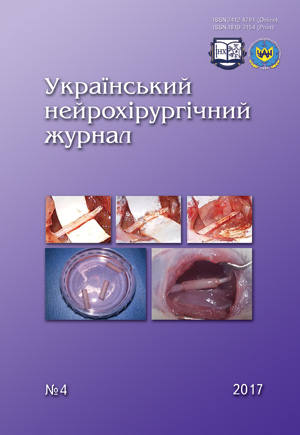Features of anesthesiological management for transnasal surgical in pituitary adenomas: literature review
DOI:
https://doi.org/10.25305/unj.115995Keywords:
pituitary adenomas, transsphenoidal neurosurgery, anesthesia, complicationsAbstract
Tumors of the pituitary gland make up about 10% of all neoplasms of the brain, mainly represented by adenomas. A feature of a larger number of adenomas is the symptoms of hypersecretion of the pituitary hormones, which leads to typical changes in the patient’s body. Surgical removal of pituitary tumors is performed through endoscopical transnasal access. Understanding the individualities of patients, the disease course and the operation course helps the anesthesiologist to ensure adequate preoperative preparation, anesthesia and postoperative management for patients, which reduces the number of complications and facilitates the early recovery of patients.
References
1. Lanzino G, Laws ER. Transsphenoidal Surgery. Elsevier Health Sciences; 2010. 336 p.
2. Dunn LK, Nemergut EC. Anesthesia for transsphenoidal pituitary surgery. Curr Opin Anaesthesiol. 2013 Oct;26(5):549-54. [CrossRef] [PubMed]
3. Guk MO. [Criteria of radicality assessment in hormonally nonactive pituitary adenomas]. Coliection of scientific works of staff member of P. L. Shupyk NMAPE. 2016;26:488-493. Ukrainian. [VernadskyNLU]
4. Nemergut EC, Dumont AS, Barry UT, Laws ER. Perioperative management of patients undergoing transsphenoidal pituitary surgery. Anesth Analg. 2005 Oct;101(4):1170-81. Review. [CrossRef] [PubMed]
5. Abraham M. Perioperative management of patients with pituitary tumours. J Neuroanaesthesiol Crit Care. 2016;3(3):211-8. [CrossRef]
6. Horvat A, Kolak J, Gopčević A, Ilej M, Gnjidić Ћ. Аnesthetic management of patients undergoing pituitary surgery. Acta Clin Croat. 2011;50:209-16. Available from: https://core.ac.uk/download/pdf/14446753.pdf
7. Bajwa SS, Bajwa SK. Anesthesia and Intensive care implications for pituitary surgery: Recent trends and advancements. Indian J Endocrinol Metab. 2011 Sep;15(Suppl.3): S224–S232. [CrossRef] [PubMed]
8. Kurnosov AB, Shmigelskiy AV, Lubnin AYu, Kalinin PL, Kutin MA, Fomichev DV, Sharipov OI. [Regional anesthesia for removal of chiasmosellar area tumors by endoscopic endonasal transsphenoidal approach]. Regional Anesthesia and Acute Pain Management. 2017;11(1):13–21. Russian. [CrossRef]
9. Rahimi E, Mariappan R, Tharmaradinam S, Manninen P, Venkatraghavan L. Perioperative management and complications in patients with obstructive sleep apnea undergoing transsphenoidal surgery: Our institutional experience. J Anaesthesiol Clin Pharmacol. 2014 Jul;30(3):351-4. [CrossRef] [PubMed] [PubMed Central]
10. Danevich OO, Guk MO, Teslenko DS. [Influence of Pituitary Apoplexy on the Clinical Course and Results of Treatment of Cushing Disease]. Problems of Endocrine Patology. 2014;(3):.67-72. Ukrainia. [VernadskyNLU]
11. Lim M, Williams D, Maartens N. Anaesthesia for pituitary surgery. J Clin Neurosci. 2006 May;13(4):413-8. [CrossRef] [PubMed]
12. Moshchev DA, Lubnin AYu, Moshkin AV, Mochenova NN, Madorskiy SV, Luk’yanov VI. [Prognostic value of D-dimer level in neurosurgical patients before elective hospitalization]. Anesteziologiya i Reanimatologiya. 2013;(4):59-63. Russian. [eLIBRARY.RU]
13. Lubnin AYu, Markina MS. Profilaktika tromboza glubokikh ven i tromboembolii legochnoy arterii u neyrokhirurgicheskikh bol’nykh. In: Savin IA, Fokin MS, Lubnin AYu, redactors. Rekomendatsii po intensivnoy terapii u patsiyentov s neyrokhirurgicheskoy patologiyey: posobiye dlya vrachey. 4th ed. Moscow: Burdenko Neurosurgery Institute; 2016. P. 92-104. Russian. Available from: http://www.nsicu.ru/book/burdenko_guideliens
14. Ali Z, Bithal PK, Prabhakar H, Rath GP, Dash HH. An assessment of the predictors of difficult intubation in patients with acromegaly. J Clin Neurosci. 2009 Aug;16(8):1043-5. [CrossRef] [PubMed]
15. Malhotra SK, Sharma K, Saini V. Pituitary Surgery and Anesthetic Management: An Update. World Journal of Endocrine Surgery. 2013 Jan 15;5(1):1–5. [CrossRef]
16. Fаbregas N, Hurtado P, Gracia I, Craen R. Anesthesia for minimally invasive neurosurgery. Rev Colomb Anestesiol. 2015 Feb;43,Suрpl.1:15-21. [CrossRef]
17. Gemma M, Tommasino C, Cozzi S, Narcisi S, Mortini P, Losa M, Soldarini A. Remifentanil Provides Hemodynamic Stability and Faster Awakening Time in Transsphenoidal Surgery. Anesth Analg. 2002 Jan;94(1):163–8. [CrossRef] [PubMed]
18. Ali Z, Prabhakar H, Bithal PK, Dash HH. Bispectral index-guided administration of anesthesia for transsphenoidal resection of pituitary tumors: a comparison of 3 anesthetic techniques. J Neurosurg Anesthesiol. 2009 Jan;21(1):10-5. [CrossRef]
19. Barak M, Yoav L, Abu el-Naaj I. Hypotensive anesthesia versus normotensive anesthesia during major maxillofacial surgery: a review of the literature. ScientificWorldJournal. 2015;2015:480728. [CrossRef] [PubMed] [PubMed Central]
20. Thongrong C, Kasemsiri P, Carrau RL, Bergese SD. Control of bleeding in endoscopic skull base surgery: current concepts to improve hemostasis. ISRN Surg. 2013 Jun 13;2013:191543. [CrossRef] [PubMed] [PubMed Central]
21. Cincikas D, Ivaskevicius J. Application of controlled arterial hypotension in endoscopic rhinosurgery. Medicina (Kaunas). 2003;39(9):852-9. English, Lithuanian. [PubMed]
22. Chaaban MR, Baroody FM, Gottlieb O, Naclerio RM. Blood Loss During Endoscopic Sinus Surgery With Propofol or Sevoflurane: a randomized clinical trial. JAMA Otolaryngol Head Neck Surg. 2013 May;139(5):510-4. [CrossRef] [PubMed]
23. Munshi FA, Bashir F, Ahad S, Rather MA. Role of esmolol and sodium nitroprusside as hypotensive agents in functional endoscopic sinus surgeries. J Evolution Med Dental Sci. 2015 Nov;4(96):16171-4. [CrossRef]
Downloads
Published
How to Cite
Issue
Section
License
Copyright (c) 2017 Lesia Y. Pechera, Mykola O. Guk, Arthur O. Mumliev

This work is licensed under a Creative Commons Attribution 4.0 International License.
Ukrainian Neurosurgical Journal abides by the CREATIVE COMMONS copyright rights and permissions for open access journals.
Authors, who are published in this Journal, agree to the following conditions:
1. The authors reserve the right to authorship of the work and pass the first publication right of this work to the Journal under the terms of Creative Commons Attribution License, which allows others to freely distribute the published research with the obligatory reference to the authors of the original work and the first publication of the work in this Journal.
2. The authors have the right to conclude separate supplement agreements that relate to non-exclusive work distribution in the form of which it has been published by the Journal (for example, to upload the work to the online storage of the Journal or publish it as part of a monograph), provided that the reference to the first publication of the work in this Journal is included.









